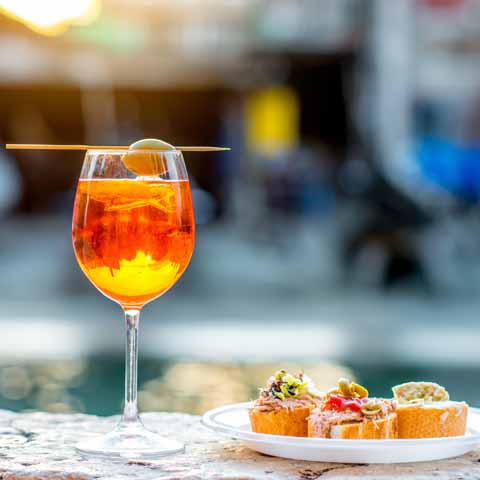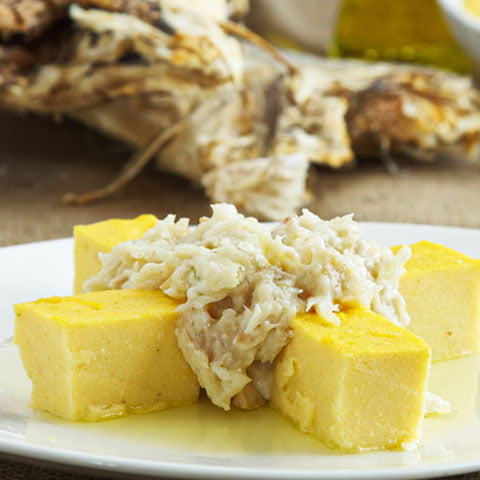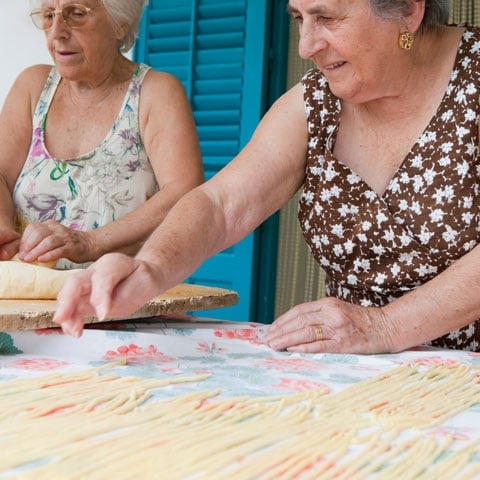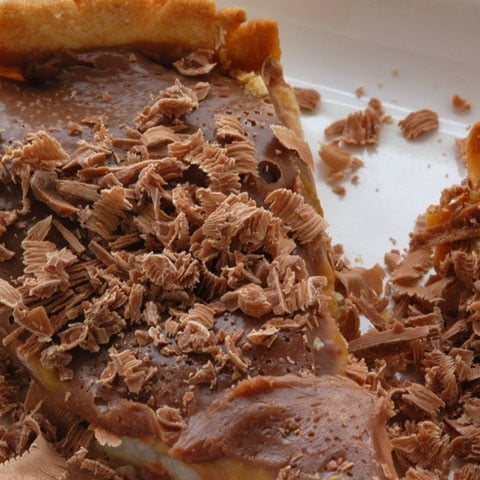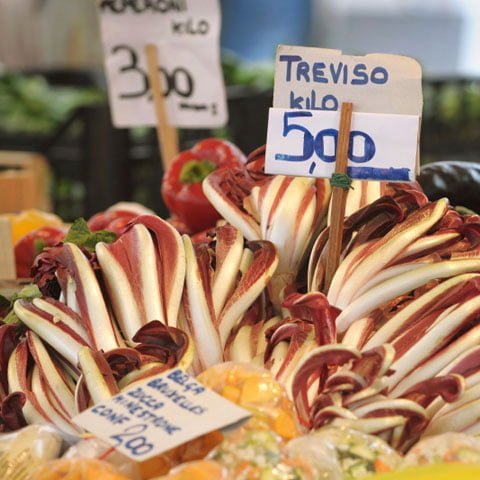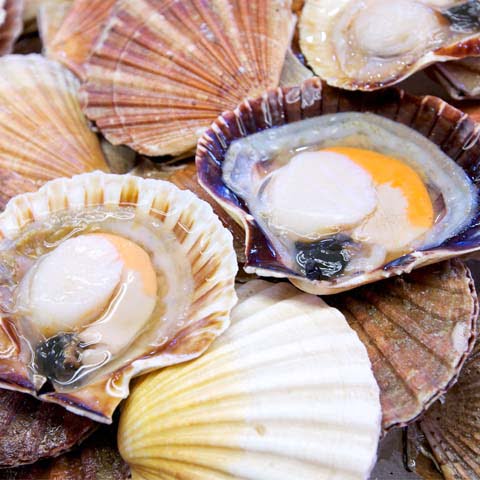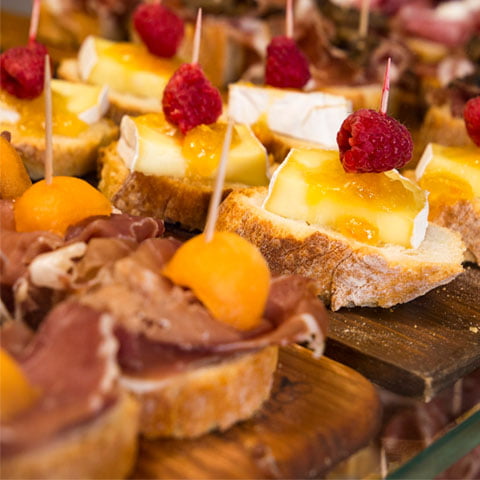The Veneto region is one of Italy’s most prized regions, with marvels both natural and manmade. With the enchanting cities of Venice and Verona, both world-renowned for their romance, to the south and the sweeping Dolomites bordering the north, Veneto is a feast for the eyes and heart alike. It also offers a feast in the traditional sense, with seasonal fare that promises farm fresh ingredients year round.
Veneto’s cuisine is as varied as its geography, but throughout the region, carbohydrates reign supreme. Rice, beans and polenta are staples in every one of Veneto’s provinces, and with the Adriatic Sea and Lake Garda flanking the region, there is always a bounty of fresh fish available.
Although clams, mussels, anchovies and crabs are harvested from the lake and the sea, it is Veneto cod that serves as the centerpiece when it comes to protein.
Every province and town provides their own variation on the Veneto cuisine theme, but they are all unified in the use of Vialone Nano rice, which is a staple in all of the region’s rice-based dishes, including risottos.
Several Veneto wines and liquors are recognized in every corner of Italy and beyond. They include the much lauded Prosecco, Amarone, and Grappa.
Appetizers
The cod is a respected fish in Veneto, and though it is incorporated into many recipes, it reaches its full potential when is mantecato. In this version, the cod is cooked until it is turned into a dense cream, which is then mixed with a generous amount of olive oil, garlic and parsley. Though it delivers distinct flavors, montecato cod is delicate enough to spread on crostini or fried polenta, a popular dish known as stoccafisso mantecato con polenta.
Italy’s city of Parma is the king of prosciutto, but Veneto has its own version, crafted in the town of Montagnana. Prosciutto Crudo Veneto Berico Euganeo is the official name, and Montagnana makes it a bit differently than the masters in Parma. Because of its unique flavor and craftsmanship, it is a popular appetizer among those in Veneto.
Every town in Veneto favors the fiori di zucca fritti, or fried courgette flowers. It’s crispy, delectable and so popular that it is a common street food in the region.
If there is one appetizer that is wholly Veneto, though, it is sarde in saor. It is the go-to starter in restaurants and showcases one of the jewels of the Adriatic – the sardine. Sarde in saor is a traditional meal put together by fishermen while on their boats, and is a combination of deep fried sardines that are stewed and then lightly fried with onions and vinegar. It is served with nuts, raisins or other add-ons, and can also be served on crostini.
Veneto restaurants are particular about where their ingredients come from, even when they are incorporated into simple recipes. One of those simple recipe is risi e bisi, a minimalist mix of rice and peas that is occasionally finished with extras like guanciale, or pork cheeks. Veneto chefs always prefer the region’s Vialone Nano rice and peas from Lumigiano, a town nestled amid the Berici Hills. The flavor in Lumigiano’s peas is unlike that found in any other pea variety, and is part of what gives the dish its signature taste.
Just as there is some variation in Italy’s best-known dishes, from region to region, so there are notable variations in cuisine from town to town in the region. A primary example of this is pasta e fasoi, a beloved winter dish that will put meat on the bones. It is slow cooked and served on a pasta base, with beans, garlic, lard, onion and celery. There are numerous variations on the pasta e fasoi theme, such as one that calls for exclusive red kidney beans, only picked during August and September, and only in the small town of Lamon.
Radicchio Trevigiano, or Treviso chicory is one of the most utilized varieties of the root around the world, and holds a special place in Veneto cuisine. It is the star in risotto al radicchio, a delicious take on risotto that brings Treviso chicory together with the region’s excellent rice.
Although Italian fare is much more than just pasta, there’s no denying its ubiquitous presence around the country. In Veneto, the signature pasta is bigoli, which is much like it sounds. Bigoli are similar to spaghetti in appearance, though much thicker. It is regularly featured in bigoli in salsa, which consists of the pasta and a dense sauce made from anchovies and onions. It can also be combined with game and meat sauces, depending on what ingredients are on hand.
Second course
Veneto is home to plenty of vibrant, imaginative, flavorful foods, but if there’s one dish that best represents the region’s culinary prowess, it is baccala alla Vicentina. It features the region’s delectable cod, bathed for two days and slow cooked with milk, olive oil and onions. It is served with polenta for a strong texture and flavor contrast.
Baccala alla Vicentina is Veneto’s most recognizable dish, but its most unique recipe might be ovi e sparasi, which is crafted using the white asparagus of Bassano. This asparagus is known for its bittersweet flavor and soft texture. Crafting ovi e sparasi means boiling the asparagus in pots specially made for the task, and then serving it with an egg, oil, salt and pepper sauce base.
And when visiting Veneto trattorias, one would be remiss if they did not partake in polenta e osei, a hearty yet easy to eat meal of skewered game and pork meat, with plenty of polenta on the side.
Cheese and Italy are inextricably linked, and Veneto produces one of the country’s most beloved. Asiago is a favorite among cheese fanatics the world over, and Veneto cheesemakers have mastered it. That’s not a surprise, as Veneto has been a center of cheese crafting for more than 1,000 years. Asiago is prized for its delicate, light taste and texture. It is served everywhere in Veneto, and is a popular pairing with pastas, charcuterie or wine.
Although it is most often found in ovi e sparasi, the white asparagus of Bassano can act as a side in many dishes. As it is rooted deeply in Veneto’s food traditions, white asparagus is prepared in many ways, all aimed at bringing out its interesting bittersweet flavor.
The Piedmont and Tuscany regions are best known for the country’s black truffles, but Veneto, and specifically the Iberici hills, produce a robust variety of black truffles as well.
Dessert
Seasonal fare is a characteristic of the cuisine in Veneto, and is particularly true of its desserts. Pandoro, for example, is everywhere during the Christmas holidays, and is a necessity with Panettone. Pandoro is made from sweet yeast bread and formed into a star, and it takes an experienced baker’s touch to create. That’s why it is usually only available through bakeries or groceries stores.
During Easter, it’s the fugazza Vicentina that serves as the seasonal dessert, and it would be fair to call it a sweet bread or focaccia. It is similar to other Italian sweet bread deserts, including Panettone, in that the bread itself is not overly sweet. It’s the addition of vanilla and lemon zest that provides a touch more sweetness and flavor.
Golosessi is a general term for the smorgasbord of biscuits that Italian bakeries produce, and Veneto bakers focus on a few of the most scrumptious. The frittelle, I buratelli, I baicoli and gli zaletti are among them, and they make for an ideal pairing with a sweet wine.
Street foods
Veneto street foods are rich and hearty, and combine protein and carbohydrates in mouthwatering fashion. The Panino con il pastin e formai is a perfect example. Most often prepared in the Belluno area, though not uncommon elsewhere, it is a sandwich of pork or beef patties, along with an infusion of white wine, garlic and spices. Cheese and polenta are standard sides, and the sandwich can be eaten raw or grilled.
A more adventurous offering is the sfilacci di cavallo, or frayed dried horse meat. Though it can be eaten as a lean, protein-dense snack, it is a treasured ingredient in sandwiches or on pizzas.
The radicchio Trevgiano all griglia is a fine spotlight onto Veneto cuisine, as it brings together the laudable Treviso chicory, which can be grilled or fried, the beans of Lamon and several cheeses lovingly crafted in the region.
For the tapas fans out there, don’t pass up on Cicchetti. Cicchetti is a sampling of many finger foods, side dishes and miniature sandwiches, which feature a medley of meat, vegetables and seafood, all served on bread or fried polenta. Bacari prepare and serve cicchetti, and there is an artistry here in how the food is presented. And, like any good Italian dish, it is served with wine.
It’s not Italian cuisine without wine, and Veneto has much to boast about here. Perhaps its most famous wine is Grappa (though locals refer to it as Graspa or Sgnapa), as it is an extremely popular after-dinner drink, or “digestive.” Originally, it was made in the town of Bassano del Grappa, and is still a staple product there. Grappa is a grape pomace brandy, with powerful fragrant notes and an alcohol by volume rating between 75 and 120 proof. Although it makes for a perfectly fine sipping wine or digestivo, it is also added to the last bit of espresso, swirled around and slurped up in one go.
Grappa may be the star, but Veneto has a deep lineup of impressive white and red wines, enough to tempt any wine lover. Ask any wine expert, and they’ll likely brand Veneto as one of the wine capitals of Italy. The Soave is the chief white wine, and can be paired with just about any meal. Other notable white wines include Gambellara and Vespaiolo.Under the red wine ledger, the Amarone is the champ, as it brings a luscious, impenetrable red color, along with a strong body. Bardolino and Valpolicella Rosso are additional red wines that shouldn’t be missed.
But as impressive as those wines are, it’s Veneto’s Prosecco that might be the most famous the world over. Native to Veneto, it is a mark of celebrations and a popular pairing with appetizers or desserts.
About Veneto:
